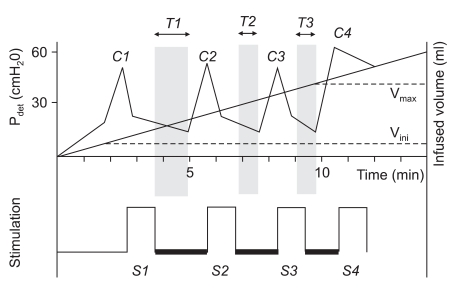Ann Rehabil Med.
2011 Oct;35(5):605-612. 10.5535/arm.2011.35.5.605.
Semiconditional Electrical Stimulation of Pudendal Nerve Afferents Stimulation to Manage Neurogenic Detrusor Overactivity in Patients with Spinal Cord Injury
- Affiliations
-
- 1Department of Rehabilitation Medicine, Yonsei University Wonju College of Medicine, Wonju 220-701, Korea. showfrog@naver.com
- KMID: 2267221
- DOI: http://doi.org/10.5535/arm.2011.35.5.605
Abstract
OBJECTIVE
To evaluate the effect of semiconditional electrical stimulation of the pudendal nerve afferents for the neurogenic detrusor overactivity in patients with spinal cord injury. Forty patients (36 males, 4 males) with spinal cord injury who had urinary incontinence and frequency, as well as felt bladder contraction with bladder filling sense or autonomic dysreflexic symptom participated in this study. METHOD: Patients with neurogenic detrusor overactivity were subdivided into complete injury and incomplete injury groups by ASIA classification and subdivided into tetraplegia and paraplegia groups by neurologic level of injury. Bladder function, such as bladder volumes infused to the bladder until the first occurrence of neurogenic detrusor overactivity (V(ini)) and the last contraction suppressed by electrical stimulation (V(max)) was measured by water cystometry (CMG) and compared with the results of each subgroup.
RESULTS
Among the 40 subjects, 35 patients showed neurogenic detrusor overactivity in the CMG study. Among these 35 patients, detrusor overactivity was suppressed effectively by pudendal nerve afferent electrical stimulation in 32 patients. The infusion volume until the occurrence of the first reflex contraction (V(ini)) was 99.4+/-80.3 ml. The volume of saline infused to the bladder until the last contraction suppressed by semiconditional pudendal nerve stimulation (V(max)) was 274.3+/-93.2 ml, which was significantly greater than V(ini). In patients with good response to the pudendal nerve afferent stimulation, the bladder volume significantly increased by stimulation in all the patients.
CONCLUSION
In this study, semiconditional electrical stimulation on the dorsal penile afferent nerve could effectively inhibit neurogenic detrusor overactivity and increase bladder volume in patients with spinal cord injury.
MeSH Terms
Figure
Reference
-
1. Abrams P, Cardozo L, Fall M, Griffiths D, Rosier P, Ulmsten U, Van Kerrebroeck P, Victor A, Wein A. The standardisation of terminology in lower urinary tract function: report from the standardisation subcommittee of the International Continence Society. Urology. 2003; 61:37–49. PMID: 12559262.
Article2. Perkash I. Long-term urologic management of the patient with spinal cord injury. Urol Clin North Am. 1993; 20:423–434. PMID: 8351768.
Article3. Wein AJ. Pharmacologic options for the overactive bladder. Urology. 1998; 51:43–47. PMID: 9495736.
Article4. Sahai A, Khan MS, Gregson N, Smith K, Dasgupta P. Botulinum toxin for detrusor overactivity and symptoms of overactive bladder: where we are now and where we are going. Nat Clin Pract Urol. 2007; 4:379–386. PMID: 17615549.
Article5. Vignes JR, Gimber E, Sesay M, De Seze M, Guerin J, Joseph PA. Treatment of overactive bladder. Operative Techniques in Neurosurgery. 2004; 7:163–174.
Article6. Wheeler JS Jr, Walter JS, Zaszczurynski PJ. Bladder inhibition by penile nerve stimulation in spinal cord injury patients. J Urol. 1992; 147:100–103. PMID: 1729491.
Article7. Fall M, Lindstrom S. Electrical stimulation. A physiologic approach to the treatment of urinary incontinence. Urol Clin North Am. 1991; 18:393–407. PMID: 2017820.8. Yoshimura N. Bladder afferent pathway and spinal cord injury: possible mechanisms inducing hyperreflexia of the urinary bladder. Prog Neurobiol. 1999; 57:583–606. PMID: 10221783.
Article9. Schmidt RA, Jonas U, Oleson KA, Janknegt RA, Hassouna MM, Siegel SW, van Kerrebroeck PE. Sacral Nerve Stimulation Study Group. Sacral nerve stimulation for treatment of refractory urinary urge incontinence. J Urol. 1999; 162:352–357. PMID: 10411037.
Article10. Kirkham AP, Shah NC, Knight SL, Shah PJ, Craggs MD. The acute effects of continuous and conditional neuromodulation on the bladder in spinal cord injury. Spinal Cord. 2001; 39:420–428. PMID: 11512072.
Article11. Dalmose AL, Rijkhoff NJ, Kirkeby HJ, Nohr M, Sinkjaer T, Djurhuus JC. Conditional stimulation of the dorsal penile/clitoral nerve may increase cystometric capacity in patients with spinal cord injury. Neurourol Urodyn. 2003; 22:130–137. PMID: 12579630.12. Hansen J, Media S, Nohr M, Biering-Sorensen F, Sinkjaer T, Rijkhoff NJ. Treatment of neurogenic detrusor overactivity in spinal cord injured patients by conditional electrical stimulation. J Urol. 2005; 173:2035–2039. PMID: 15879820.
Article13. Lee JM, Lee YH, Lee SS, Jang SM, Song JM, Song KH. Inhibition of Hyper-reflexic detrusor contraction by sacral afferent nerve stimulation in spinal cord injury. J Korean Acad Rehabil Med. 2001; 25:956–964.14. Ishigooka M, Suzuki Y, Hashimoto T, Sasagawa I, Nakada T, Handa Y. A new technique for sacral nerve stimulation: a percutaneous method for urinary incontinence caused by spinal cord injury. Br J Urol. 1998; 81:315–318. PMID: 9488079.
Article15. Ishigooka M, Hashimoto T, Hayami S, Suzuki Y, Nakada T, Handa Y. Electrical pelvic floor stimulation: a possible alternative treatment for reflex urinary incontinence in patients with spinal cord injury. Spinal Cord. 1996; 34:411–415. PMID: 8963996.
Article16. Previnaire JG, Soler JM, Perrigot M, Boileau G, Delahaye H, Schumacker P, Vanvelcenaher J, Vanheé JL. Short-term effect of pudendal nerve electrical stimulation on detrusor hyperreflexia in spinal cord injury patients: importance of current strength. Paraplegia. 1996; 34:95–99. PMID: 8835034.17. Lindstrom S, Fall M, Carlsson CA, Erlandson BE. The neurophysiological basis of bladder inhibition in response to intravaginal electrical stimulation. J Urol. 1983; 129:405–410. PMID: 6834523.18. Tanagho EA, Schmidt RA. Electrical stimulation in the clinical management of the neurogenic bladder. J Urol. 1988; 140:1331–1339. PMID: 3057221.
Article19. Lee YH, Creasey GH. Self-controlled dorsal penile nerve stimulation to inhibit bladder hyperreflexia in incomplete spinal cord injury: a case report. Arch Phys Med Rehabil. 2002; 83:273–277. PMID: 11833034.
Article
- Full Text Links
- Actions
-
Cited
- CITED
-
- Close
- Share
- Similar articles
-
- Determination of Rectal Afferents, Based on the Analysis of Cerebral Evoked Potentials Induced by Rectal Stimulation
- Effect of Rectal Electrical Stimulation in Patients with Neurogenic Bowel due to Spinal Cord Injury
- Detrusor and Blood Pressure Responses to Dorsal Penile Nerve Stimulation during Hyper-reflexic Bladder Contraction in Patients with Cervical Cord Injury
- Inhibition of Hyper-reflexic Detrusor Contraction by Sacral Afferent Nerve Stimulation in Spinal Cord Injury
- Effects of the Electrical Stimulation for the Neurogenic Bowel according to the Level of Spinal Cord Injury




